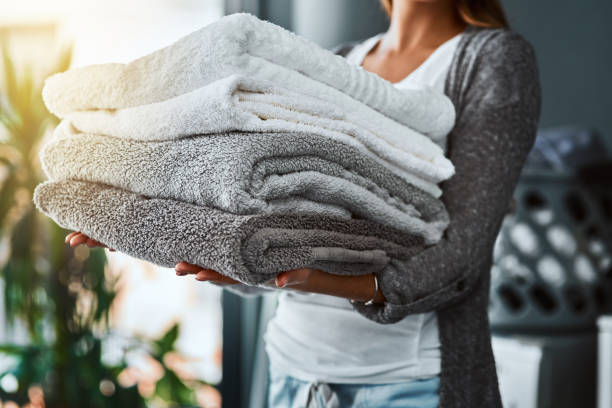
Nothing quite ruins a good morning like stepping out of a warm shower only to wrap yourself in a towel that feels like it could double as a kitchen scourer.
If you've been blaming your washing machine or detergent for those scratchy, stiff towels, you might be surprised to learn the real culprit could be hiding in your linen cupboard.
Despite regular washing, your favourite towel goes from soft, fluffy, and absorbent to matted, scratchy, and uncomfortable.
The good news? This frustrating problem often has a surprisingly simple solution that doesn't involve buying expensive products or replacing your towels entirely.
The storage mistake that's sabotaging your towels
Hotel linen experts from Richard Howarth shared their tips for soft towels, revealing that stacking towels can impact the texture.
When towels are stacked tightly on top of each other, the weight compresses the fibres, flattening those lovely loops that make towels feel fluffy and absorbent.
But it's not just the compression that's the problem. Stacking the towels so compactly prevents air circulation around the towels leading to a build up of moisture that can reduce their fluffiness.
This trapped moisture can also create conditions perfect for mould and mildew—something particularly concerning in Australia's humid climate.
'To keep towels fluffy, it's important to store them in a well-ventilated area where they can fully dry between uses'
Australia's humidity challenge
Living in Australia means dealing with humidity levels that can make towel care particularly challenging. The bathroom is in many ways a perfect breeding ground for mould, which is why keeping mould out of your bathroom should be a priority.
While the southern and some parts of the eastern states of Australia have difficulties drying towels in cold weather, for people in northern climates, it's humidity that is our biggest bugbear. Humid conditions slow down the process of drying towels, simply because there is too much water in the air.
Understanding Australian humidity levels
Dust mites thrive in humidity levels at and above 70 per cent
Humidity levels of 70 per cent are ideal for mould growth
Mould can grow at any level above 55 per cent
Optimal indoor humidity: 30 to 50 per cent
The right way to fold and store towels
The experts recommend a simple change in technique. Instead of stacking towels high, fold them in half lengthways and then fold in thirds. If you prefer rolling them, lay them flat, fold in half, then roll up neatly.
The key is storage: arrange towels side by side rather than in towering piles. Store your towels in a dry, well-ventilated area. This allows air to circulate around each towel, preventing moisture buildup and keeping those fibres from getting compressed and matted.
Why bathroom storage isn't ideal
While it's convenient to keep towels in the bathroom, it might not be the best choice for maintaining their quality. There is one part of every household, no matter where you live in Australia, where moisture and humidity are common, and that's the bathroom.
Bathrooms are notoriously humid spaces where fungi develop best in warm, humid environments where there is both excessive moisture and poor ventilation. However, you might also find mould spots elsewhere in your bathroom, such as on your bathroom towels.
Better towel storage locations
- Linen closet with good ventilation
- Bedroom wardrobe with space between towels
- Hallway cupboard away from humidity sources
- Laundry cupboard (if well-ventilated)
- Any cool, dry area with air circulation
Beyond storage: washing techniques that make a difference
Storage is just one part of the equation. Common culprits that lead to build-up include hard water, dryer sheets, detergent residue (especially powdered detergent), and overuse of detergent and fabric conditioners can leave residues that harden the fabric.
Use half the recommended amount of detergent when washing towels, as using half the recommended amount of detergent can help keep towels soft. This prevents soap buildup that makes towels feel stiff and scratchy.
The vinegar and baking soda solution
Add white vinegar or baking soda to your wash cycle. These natural ingredients break down detergent residues and soften towel fibres, keeping them fluffy.
Using white vinegar once every 6 weeks will remove any detergent and fabric softener residue that has built up. Then run a second wash cycle with 1 cup of white vinegar.
Adding baking soda to your towel wash helps remove soap and chemical residue that can end up covering your towels. Add half a cup of baking soda with your washing detergent, then wash as usual.
Drying techniques that preserve fluffiness
Shake towels before drying to loosen fibers. Tumble dry on low heat with wool dryer balls or tennis balls for optimal fluffiness without damaging the fabric.
You don't need to buy specific dryer balls; a tennis ball will do. Throw one or two in the dryer with your towels. It will help them dry quicker and agitate the fibres, further helping soften up your towels.
For those without a dryer, use a clothes horse next to a heater or even better, dry them outside on a windy day. The wind will help keep them moving and agitate the fibres, just like a tumble in a dryer would.
Health considerations for Australian seniors
For older Australians, the health implications of improper towel storage extend beyond just comfort. Mould can be bad for your health and can trigger issues such as nasal congestion, sneezing, coughing and wheezing.
It can also cause respiratory infections and be a particular issue for those with asthma, lung diseases, weakened immune systems and allergies.
Mould is particularly worrying for people who are susceptible to these types of issues, such as asthmatics and those with weakened immune systems. This makes proper towel storage not just about comfort, but about maintaining a healthy home environment.
Did you know?
Did you know?
Bathroom towels made from natural fibers are especially vulnerable, as these are hygroscopic meaning they absorb water and moisture quickly, but dry out slowly. Cottons or linens will tend towards molding above 80 per cent humidity.
Rescuing already-stiff towels
If your towels have already succumbed to the scratchy curse, don't despair. Start by washing them with a cup of white vinegar in the hot water cycle, followed by a second wash using baking soda. This dual treatment helps break down mildew and eliminate stubborn odors without harsh chemicals.
If you have had your towels for a long time or your towels are poor quality, there probably won't be anything you can do to make your towels soft again. And it's probably about time you replaced them!
Money-saving tips for towel care
Rather than constantly replacing towels or buying expensive fabric treatments, these household solutions can save you money:
- White vinegar costs under $2 and can treat dozens of loads
- Baking soda is equally affordable and multipurpose
- Tennis balls cost a few dollars and last for years as dryer aids
- If you ran your heated towel rail all day you could expect to pay less than $2 a day. If you ran it for much less, which is recommended—you could end up paying less than 20 cents a day in running costs
What This Means For You
The simple act of changing how you store your towels—giving them space to breathe rather than squashing them together—combined with these care techniques can transform your daily routine. No more dreading the post-shower wrap-up, and no more towels that feel like they belong in the garage rather than the bathroom.
What storage mistakes have you been making with your towels? Have you noticed a difference in humidity affecting your laundry in different parts of Australia? Share your towel care victories (or disasters) in the comments below—we'd love to hear what works best in your home!
Original Article
https://honey.nine.com.au/living/st...scratchy/2e32bf1d-e69a-4a9c-ad66-c7dee9f53006
How to keep mould out of your bathroom | Eskimo Blog
Cited text: However, there is one part of every household, no matter where you live in Australia, where moisture and humidity are common and that’s the bathroom. ...
Excerpt: The bathroom is in many ways a perfect breeding ground for mould, which is why keeping mould out of your bathroom should be a priority.
https://eskimoheat.com.au/blogs/blog/how-to-keep-mould-out-of-your-bathroom
How to dry towels in humid weather? | Eskimo Blog
Cited text: While the southern and some parts of the eastern states of Australia have difficulties drying towels in cold weather, for people in northern climates ...
Excerpt: While the southern and some parts of the eastern states of Australia have difficulties drying towels in cold weather, for people in northern climates it
https://eskimoheat.com.au/blogs/blog/how-to-dry-towels-in-humid-weather
How to dry towels in humid weather? | Eskimo Blog
Cited text: Humid conditions slow down the process of drying towels, simply because there is too much water in the air.
Excerpt: Humid conditions slow down the process of drying towels, simply because there is too much water in the air.
https://eskimoheat.com.au/blogs/blog/how-to-dry-towels-in-humid-weather
Indoor humidity levels—Sensitive Choice
Cited text: Dust mites thrive in humidity levels at and above 70 per cent (particularly when combined with temperatures of 20-25 degrees Celsius).
Excerpt: Dust mites thrive in humidity levels at and above 70 per cent, while humidity levels of 70 per cent are ideal for mould growth, although mould can grow at any level above 55 per cent.
https://www.sensitivechoice.com/resource/indoor-humidity-levels/
Indoor humidity levels—Sensitive Choice
Cited text: Humidity levels of 70 per cent are ideal for mould growth, although mould can grow at any level above 55 per cent.
Excerpt: Dust mites thrive in humidity levels at and above 70 per cent, while humidity levels of 70 per cent are ideal for mould growth, although mould can grow at any level above 55 per cent.
https://www.sensitivechoice.com/resource/indoor-humidity-levels/
Indoor humidity levels—Sensitive Choice
Cited text: Preventing and drawing out excess moisture from your home will help maintain an optimal indoor humidity level between 30 to 50 per cent.
Excerpt: Maintaining an optimal indoor humidity level between 30 to 50 per cent can help reduce or eliminate the likelihood of dust mites or mould developing.
https://www.sensitivechoice.com/resource/indoor-humidity-levels/
How To Keep Towels Soft And Fluffy Wash After Wash—Fabricare Center
Cited text: Store your towels in a dry, well-ventilated area.
Excerpt: Store your towels in a dry, well-ventilated area.
https://fcdrycleaners.com/blog/laundry/how-to-keep-towels-soft-and-fluffy-wash-after-wash/
How to keep mould out of your bathroom | Eskimo Blog
Cited text: However, there is one part of every household, no matter where you live in Australia, where moisture and humidity are common and that’s the bathroom.
Excerpt: There is one part of every household, no matter where you live in Australia, where moisture and humidity are common and that
https://eskimoheat.com.au/blogs/blog/how-to-keep-mould-out-of-your-bathroom
You've Got Mold Growing On Your Towels. Is It Too Late To Save Them? Here's Our Tip—House Digest
Cited text: This fungi develops best in warm, humid environments where there is both excessive moisture and poor ventilation.
Excerpt: fungi develops best in warm, humid environments where there is both excessive moisture and poor ventilation.
https://www.housedigest.com/1881682/why-mold-spots-grow-bathroom-towels-how-to-fix-them/
You've Got Mold Growing On Your Towels. Is It Too Late To Save Them? Here's Our Tip—House Digest
Cited text: However, you might also find mold spots elsewhere in your bathroom, such as on your bathroom towels.
Excerpt: However, you might also find mold spots elsewhere in your bathroom, such as on your bathroom towels.
https://www.housedigest.com/1881682/why-mold-spots-grow-bathroom-towels-how-to-fix-them/
How To Keep Towels Soft And Fluffy Wash After Wash—Fabricare Center
Cited text: Overuse of Detergent/Conditioner: Excess detergent and fabric conditioners can leave residues that harden the fabric.
Excerpt: Common culprits that lead to build-up include hard water, dryer sheets, detergent residue (especially powdered detergent), and overuse of detergent and fabric conditioners can leave residues that harden the fabric.
https://fcdrycleaners.com/blog/laundry/how-to-keep-towels-soft-and-fluffy-wash-after-wash/
How To Keep Towels Soft And Fluffy Wash After Wash—Fabricare Center
Cited text: Moderate Detergent Use: Use half the recommended amount of detergent when washing towels.
Excerpt: Use half the recommended amount of detergent when washing towels, as using half the recommended amount of detergent can help keep towels soft.
https://fcdrycleaners.com/blog/laundry/how-to-keep-towels-soft-and-fluffy-wash-after-wash/
How To Keep Towels Soft And Fluffy Wash After Wash—Fabricare Center
Cited text: To keep towels soft, use half the recommended amount of detergent.
Excerpt: Use half the recommended amount of detergent when washing towels, as using half the recommended amount of detergent can help keep towels soft.
https://fcdrycleaners.com/blog/laundry/how-to-keep-towels-soft-and-fluffy-wash-after-wash/
How To Keep Towels Soft And Fluffy Wash After Wash—Fabricare Center
Cited text: Use Vinegar and Baking Soda: Add white vinegar or baking soda to your wash cycle. These natural ingredients break down detergent residues and soften t...
Excerpt: Add white vinegar or baking soda to your wash cycle. These natural ingredients break down detergent residues and soften towel fibers, keeping them fluffy.
https://fcdrycleaners.com/blog/laundry/how-to-keep-towels-soft-and-fluffy-wash-after-wash/
How to Make Towels Soft Again | Scooms
Cited text: Using white vinegar once every 6 weeks will remove any detergent and fabric softener residue that has built up.
Excerpt: Using white vinegar once every 6 weeks will remove any detergent and fabric softener residue that has built up.
https://scooms.com/pages/how-to-make-towels-soft-again
How to Make Towels Soft Again | Scooms
Cited text: Then run a second wash cycle with 1 cup of white vinegar.
Excerpt: Then run a second wash cycle with 1 cup of white vinegar.
https://scooms.com/pages/how-to-make-towels-soft-again
How to Make Towels Soft Again | Scooms
Cited text: Adding baking soda to your towel wash helps remove soap and chemical residue that can end up covering your towels. Add half a cup of baking soda with ...
Excerpt: Adding baking soda to your towel wash helps remove soap and chemical residue that can end up covering your towels.
https://scooms.com/pages/how-to-make-towels-soft-again
How To Keep Towels Soft And Fluffy Wash After Wash—Fabricare Center
Cited text: Proper Drying Techniques: Shake towels before drying to loosen fibers.Tumble dry on low heat with wool dryer balls or tennis balls for optimal fluffin...
Excerpt: Shake towels before drying to loosen fibers. Tumble dry on low heat with wool dryer balls or tennis balls for optimal fluffiness without damaging the fabric.
https://fcdrycleaners.com/blog/laundry/how-to-keep-towels-soft-and-fluffy-wash-after-wash/
How to Keep Towels Soft and Fluffy | Secret Linen Store
Cited text: You don
Excerpt: You don
https://www.secretlinenstore.com/blogs/the-bedspread/how-to-keep-towels-soft
How to Keep Towels Soft and Fluffy | Secret Linen Store
Cited text: Use a clothes horse next to a heater or even better, dry them outside on a windy day. The wind will help keep them moving and agitate the fibres, just...
Excerpt: use a clothes horse next to a heater or even better, dry them outside on a windy day.
https://www.secretlinenstore.com/blogs/the-bedspread/how-to-keep-towels-soft
How to keep mould out of your bathroom | Eskimo Blog
Cited text: Mould can be bed for your health and can trigger issues such as nasal congestion, sneezing, coughing and wheezing. It can also cause respiratory infec...
Excerpt: Mould can be bad for your health and can trigger issues such as nasal congestion, sneezing, coughing and wheezing.
https://eskimoheat.com.au/blogs/blog/how-to-keep-mould-out-of-your-bathroom
How to dry towels in humid weather? | Eskimo Blog
Cited text: Mould is particularly worrying for people who are susceptible to these types of issues, such as asthmatics and those with weakened immune systems.
Excerpt: Mould is particularly worrying for people who are susceptible to these types of issues, such as asthmatics and those with weakened immune systems.
https://eskimoheat.com.au/blogs/blog/how-to-dry-towels-in-humid-weather
You've Got Mold Growing On Your Towels. Is It Too Late To Save Them? Here's Our Tip—House Digest
Cited text: Bathroom towels made from natural fibers are especially vulnerable, as these are hygroscopic meaning they absorb water and moisture quickly, but dry o...
Excerpt: Bathroom towels made from natural fibers are especially vulnerable, as these are hygroscopic meaning they absorb water and moisture quickly, but dry out slowly.
https://www.housedigest.com/1881682/why-mold-spots-grow-bathroom-towels-how-to-fix-them/
How to Protect Towels from Mildew and Humidity: Summer Tips for Guests and Property Owners—InnStyle—Hospitality Products at Wholesale Prices
Cited text: Start by washing them with a cup of white vinegar in the hot water cycle, followed by a second wash using baking soda. This dual treatment helps break...
Excerpt: Start by washing them with a cup of white vinegar in the hot water cycle, followed by a second wash using baking soda.
https://blog.innstyle.com/2025/05/towels-from-mildew-humidity/
How to Make Towels Soft Again | Scooms
Cited text: Spoiler alert: If you have had your towels for a long time or your towels are poor quality, there probably won
Excerpt: If you have had your towels for a long time or your towels are poor quality, there probably won
https://scooms.com/pages/how-to-make-towels-soft-again
How to dry towels in humid weather? | Eskimo Blog
Cited text: While energy outputs between models could differ, if you ran your heated towel rail all day you could expect to pay less than $2 a day. If you ran it ...
Excerpt: If you ran your heated towel rail all day you could expect to pay less than $2 a day.
https://eskimoheat.com.au/blogs/blog/how-to-dry-towels-in-humid-weather







